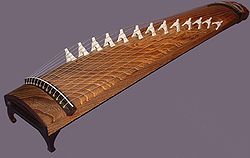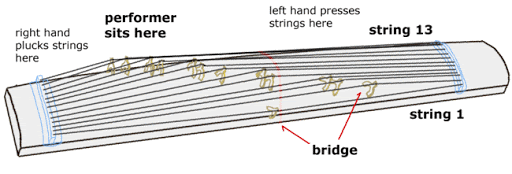
The Koto is a string plucked chordophone invented by the Chinese and was originally called the guzheng. Initially it only had 5 strings, but over the years the amount increased gradually up until the final 13 silk string version was adapted during the Nara Period. This period was when the koto was first introduced to Japan during the 7th century. When the koto was brought to Japan, it originally was a word used to describe all string instruments but later changed when more instruments were created. In the present day, the 13 string variant is still the most popular, but more recently there have been works written for 17 string bass koto’s as well as some with 20 to 25 strings. Regarding materials, it is built with paulownia wood and is around 74 inches long. The koto is often decorated with materials like metal figures, tortoise shells, as well as inlays of ebony and ivory.

When playing the koto, the performer is either kneeling or seated on the floor and the koto is held off the floor by 2 legs, or a storage box. More recently in modern concerts, it is placed on a stand so the performer can sit on a chair. To produce notes, one hand is used, the right for plucking the strings with your thumb and first two fingers. After the 16th century, people began to adapt the left hand to alter the pitch by pressing down strings to the left of the bridges. The koto also uses various pentatonic tunings as well in relation to the type of music being played. Originally the koto was only to be played by blind men and it was not allowed for women to play the instrument nor teach it. Later this rule was removed and now the koto is available for anyone to play. For early day repertoire, Yatsuhashi Kengyo, played an important role in establishing a new style of koto music called kumi uta. Before their breakthrough, the koto was only used to play a limited selection of 6 songs. Many years later Michio Miyagi was considered to be the first Japanese composer to combine western music and traditional koto music. Michio wrote over 300 new works for the koto before he died in a train accident at the age of only 62. In the present day the koto has evolved to be used in jazz, experimental music, and even pop. June Kuramoto of the jazz fusion group Hiroshima was one of the first performers to popularize the koto in non-traditional jazz fusion. Also very recently, a synthesized koto was used in Dr. Dre’s famous 1999 song, Still D.R.E.
A famous practitioner of the modern day koto is Elizabeth Falconer who studied for 10 years at the Sawai Koto School in Tokyo under 3 teachers. Elizabeth has created 1 album for the koto named Deep Pool and is featured on another album called Emerging, which is a collection of songs from 13, 17, and 20 string kotos. She currently lives in Seattle Washington where she teaches koto.

Written by Jayson Bubel
Categories
Calendar
| M | T | W | T | F | S | S |
|---|---|---|---|---|---|---|
| 1 | 2 | 3 | 4 | 5 | 6 | |
| 7 | 8 | 9 | 10 | 11 | 12 | 13 |
| 14 | 15 | 16 | 17 | 18 | 19 | 20 |
| 21 | 22 | 23 | 24 | 25 | 26 | 27 |
| 28 | 29 | 30 | 31 | |||